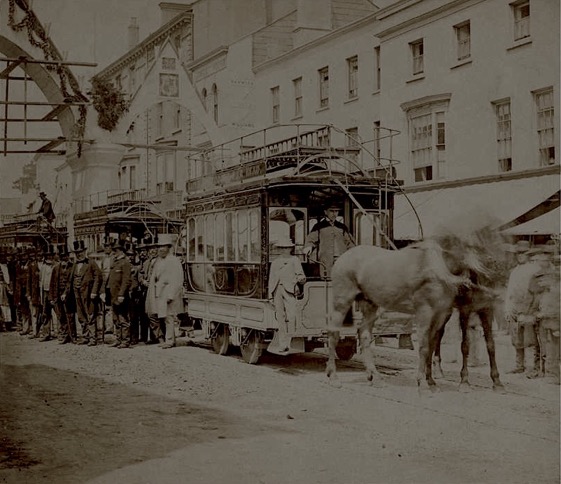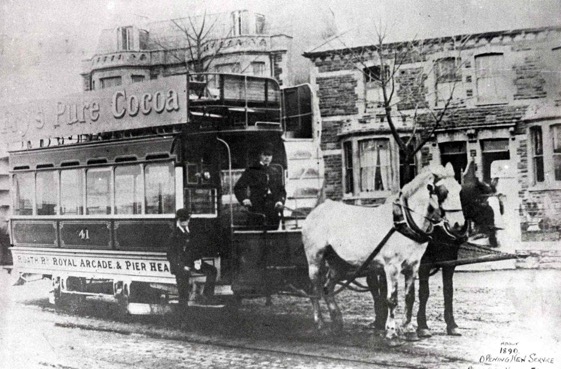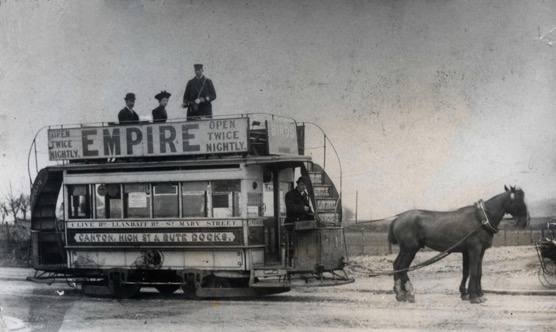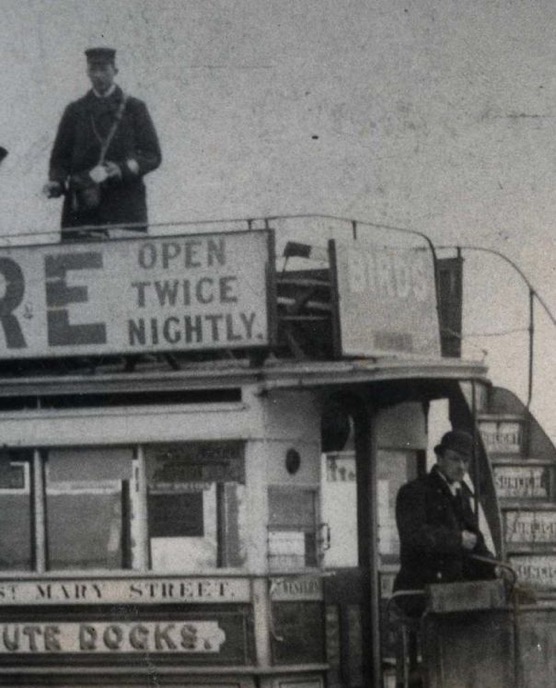Cardiff Tramways Company
History
Cardiff's first horse tramway, which opened on the 12th July 1872, was built and owned by the Cardiff Tramways Company, a subsidiary of the Provincial Tramways Company.
The PTCo, which was established in London in 1872, was involved with tramway operation for over fifty years, either owning or controlling the following concerns: General Tramways Company of Portsmouth (1878-1883); Gosport and Fareham Tramways (1905-1929); Gosport Street Tramways (1882-1883); Great Grimsby Street Tramways (1881-1936); Landport and Southsea Tramways (1878-1883); London Southern Tramways (1883-1906); Plymouth, Stonehouse and Devonport Tramways (1872-1922); Portsdown and Horndean Light Railway (1903-1935); Portsmouth (Borough), Kingston, Fratton and Southsea Tramways (1885-1892); and Portsmouth Street Tramways (1874-1905).
The CTCo's system, which was standard gauge, eventually totalled 6.31 miles, comprising lines: southwards to Bute Docks Pier Head (via Bute St) and to Clarence Rd (via Corporation Rd); eastwards to Roath; westwards to Victoria Park in Canton; and northwards to Cathays.
The company appears to have been a profitable concern, judging by its expansion during the 1870s, but in 1879, a local horse omnibus proprietor and entrepreneur — Solomon Andrews — responded to the CTCo's latest extension by implementing services that directly competed with those of the CTCo. The two companies had up until this time peacefully co-existed, but from now on the gloves were off, and their previously harmonious relationship rapidly deteriorated. This culminated in 1881/1882 with Andrews not only acquiring the lease of the newly built Cardiff District and Penarth Harbour Tramways — which the CTCo no doubt thought they should have had — but also patenting a new type of omnibus that was expressly designed to run on tramway rails. The competition significantly impacted the CTCo's profitability, a situation which was only remedied in 1888 when the PTCo (the CTCo's parent company) bought Solomon Andrews' transport interests in Cardiff, Portsmouth and Plymouth, where he had also set up in opposition to PTCo-owned tramways. As a direct consequence of this, the lease of the CD&PHT, which the PTCo had taken over, was sub-let to the CTCo, who operated the line from the 1st April 1888 onwards. It is believed that the CD&PHT line was operated wholly independently of the CTCo's wider system.
With Solomon Andrews now gone from the scene, the company seems to have settled down to a comfortable existence financially, the only issue of note being persistent problems between the company and its workforce, including strikes. Storm clouds were, however, to appear in the mid-to-late 1890s, when Cardiff Corporation began to contemplate building a modern electric tramway system.
In 1898, the corporation acquired powers to build and run its own tramway, as well as to compulsorily purchase the tramway assets of the CTCo and the CD&PHTCo. The corporation took possession of the CTCo's tracks on the 1st January 1902, as well as its tramway assets (cars and horses etc.). However, this was not the end of the CTCo, as the corporation and the CD&PHTCo took over 12 months to reach agreement on the valuation of the company, so the CTCo continued to work the CD&PHTCo's line (as the lessee) until the 10th February 1903, when the corporation finally took possession.
Uniforms
Photographs of Cardiff's horse tramways are surprisingly rare, and those that show tramway staff are rarer still, so details of uniforms are as a consequence, very sketchy. The first shot below was very probably taken on the opening day (12th July 1872), and shows a multitude of civic dignitaries, but only one regular employee, namely, the driver of the first horse car. This photo strongly suggests that drivers initially wore informal but smart attire, along with the fashionable headgear of the day, at this time, the bowler hat. As no conductors are in evidence in this very early photo, it is currently impossible to say whether or not they were issued with uniforms in the early years of operation, though a surviving marked button strongly suggests that they were (see link). It was in fact fairly common for horse-tramway operators to issue uniforms to conductors, but not to drivers.
By the 1890s, both drivers and conductors were wearing informal attire, a situation which persisted until the takeover by Cardiff Corporation in 1902.
Photographs of inspectors have not survived, so it is currently unclear what uniforms they wore (if any).
Further reading
For a brief history of the company, see 'Cardiff's Electric Tramways' by David Gould; Oakwood Press (1974).
Images
Horse tram drivers and conductors
A very early horse-tramway era photograph depicting several cars of the Cardiff Tramways Company in High St, on what was almost certainly the opening day of services (12th July 1872). The only horsecar employee in evidence is the driver of the first tram, who is wearing informal attire, a very common practice amongst UK horse tram operators. Photo courtesy of the Tramways and Light Railway Society, with thanks to David Voice.
A rather pristine-looking Horsecar No 41 on what is purportedly the opening day of the new Royal Oak-Newport Rd-Pier Head service, dating the photograph to the early 1890s. Both the conductor and the driver are wearing smart but informal attire; the conductor was apparently called John William Bendall and the driver, G Pyke. Photo courtesy of the Tramways and Light Railway Society, with thanks to David Voice.
A tatty-looking but unidentified horsecar working the Canton-High St-Bute Docks route — photo undated, but possibly taken in the mid-to-late 1890s. Photo courtesy of the Tramways and Light Railway Society, with thanks to David Voice.
An enlargement of the above photograph showing the driver and conductor, the latter apparently called Jack Dalgliesh. The driver is in informal attire, whilst the conductor appears to be wearing a soft-topped peaked cap and a greatcoat. Whether these were company-issued is unclear.